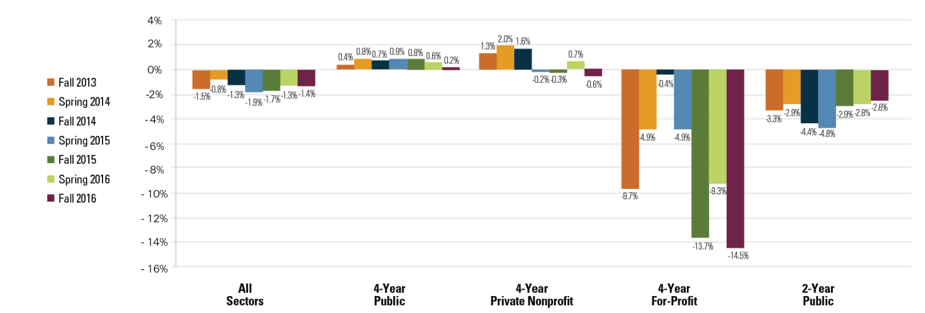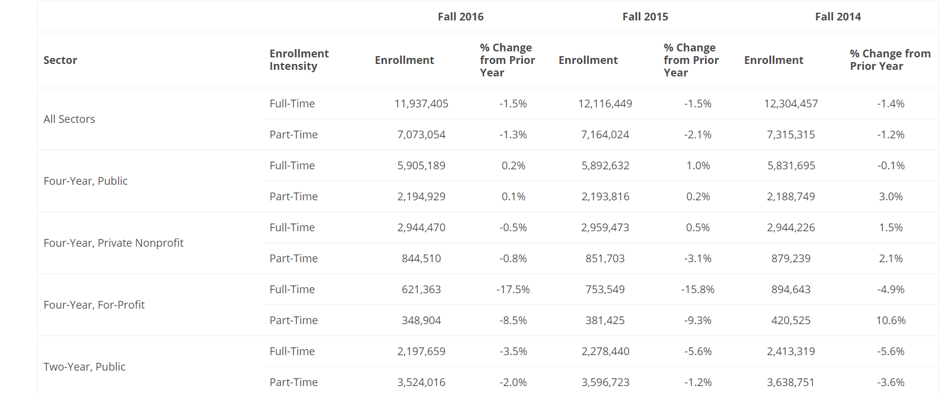UPCEA created the Center for Research and Marketing Strategy (CREMS) in response to the need for benchmarking information and actionable market research among the Association’s nearly 400 colleges and universities. In this recurring feature, CREMS Director Jim Fong shares data that should be particularly relevant and timely for those in professional, continuing, and online education.
Over the past half century, colleges and universities have relied heavily on the associate, bachelor’s or graduate degree as their financial foundations. Historically, the volume of enrollments primarily came from high school graduates seeking a bachelor’s degree on a full-time basis. However, despite the fact that the nation is experiencing the highest graduation rates in its history, the number entering directly into college is in fact declining. With 83% of high schoolers graduating, as compared to graduation rates from a decade ago at 71%, and with the population of 18 year-olds being relatively flat over the past decade, the number entering college should be increasing or at least flat.
The early results of what should be slightly increasing high school enrollments is reported by the National Student Clearinghouse (see Table 1). The Clearinghouse reports a decline of full-time college enrollments of 1.5% from fall 2015 to fall 2016. The change from the previous year was also a decline of 2% and prior to that it was a decline of 0.5%.
Figure 1 – US College Enrollment Rates (Percent Change from Previous Year)

Source: https://nscresearchcenter.org/wp-content/uploads/CurrentTermEnrollment-Fall2016.pdf
Table 1 – Estimated National Enrollment by Sector and Intensity Level
(Title IV, Degree Granting Institutions)

There are many factors that are contributing to the decline of enrollments, some of which include:
- Increasing tuition costs value may be causing some of the decline, especially among lower income populations. In addition, college graduates are leaving with $37,172 in loans, up 6% from the 2015 graduating class.
- More educational opportunities are available to high school graduates through online learning, noncredit programs, massive open online courses (MOOCs) and boot camps.
- Students may be questioning the perceived value of the educational product and the debt required to earn it. Students may be questioning whether a bachelor’s degree and changes in the economy are in alignment. As a result, they may be considering other educational options.
- High school graduates, as part of the Generation Z cohort (generally known to be born between the mid-1990s and mid-2000s), may be more likely to seek out “gap year” opportunities, such as travel or early internships to gain experience.

With the number of high schoolers likely to be flat annually and decreasing significantly in a number of Northeastern or Middle Atlantic states, the pressure on colleges and universities is expected to increase. In addition, professional, continuing, and online education units (PCO) could be well-positioned to reduce the financial challenges brought on by declining high school enrollments. These PCO units will have to offset annual loses of 0.5% to 2.0% (which could amount to a great deal over a three- to five-year period) by diversifying their educational streams through more badges and certificates.
Given the fast rate of change within just a few sectors, such as robotics, autonomous vehicles, and healthcare, coupled with growth in the badging and coding boot camp movement, one could surmise that the value of traditional higher education may be losing equity with the business community. In addition, over the past five years (now reaching $70.7 billion), U.S. corporations report increases in training dollars, but in contrast, are seeing declines in tuition reimbursement, further signs that the traditional, baccalaureate-based higher education model is out of alignment with business and industry.
Higher education, as a result, must diversify its educational portfolio to better serve not only the high school graduate, but also the non-graduate and the college graduate. What few leaders fail to realize is that education and revenues don’t stop with the bachelor’s or master’s degree, but can be furthered through certificates and badges aimed at Generation Z non-high school graduates and Millennial college graduates, among others. A recent Blackboard/UPCEA survey shows that members of the Generation Z and Millennial cohorts are very open to alternative credentialing. In fact, an alternative credential such as a certificate can also serve as a feeder for a degree later on. The National Student Clearinghouse reported that 60,000 out of 231,029 certificate holders went on to an associate’s degree.
Colleges and universities need to embrace these new forms of learning to offset losses due to lower high school graduate participation. Investments should be made to PCO units in developing new forms of learning, as well as appropriate and effective marketing of students seeking them. Institutions of higher education refusing to expand or experiment in these areas as Millennials and Generation Z’ers age are likely to die a slow death. In fact, the writing is on the wall for many as more colleges and universities are struggling to keep their doors open.
Jim Fong has more than twenty years working as a marketer and researcher in the higher education community. Prior to joining UPCEA’s Center for Research and Marketing Strategy, Jim worked as a higher education strategic marketing consultant and researcher for two firms and prior to that was the Director of Marketing, Research and Planning for Penn State Outreach.

